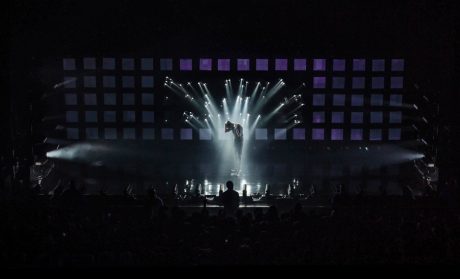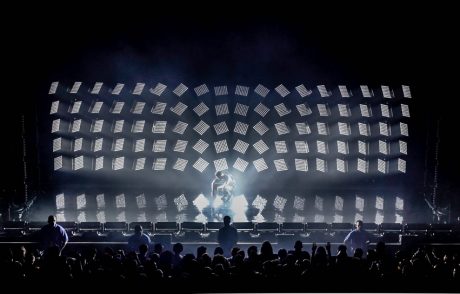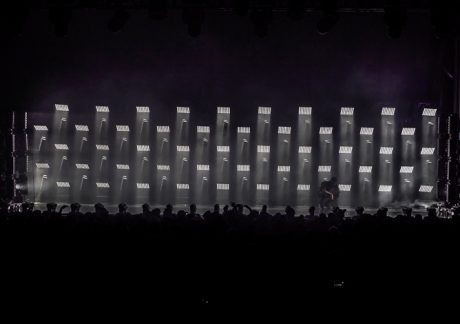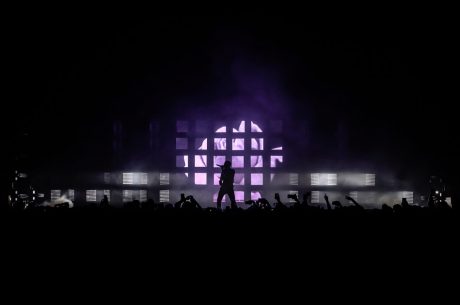
LAS VEGAS – Currently performing at festivals across Europe, American rap and hip hop artist, Vince Staples, spent the first quarter of the year in the USA opening for headliner, Tyler, the Creator. For performance artists as radical and dynamic as these, a lighting rig has to perform on many levels, reflecting the tone and style of each performer and each song, and supporting each artist on the stage without taking the focus away from their singular performances.
More details from Ayrton (www.ayrton.eu):
To give each of the artists a dramatically different visual definition for their respective parts of the show, two incredibly contrasting looks were devised, with Staples’ performance taking place in front of a dramatic backdrop that juxtaposed cold white, stark and graphic looks, which then gave way to Tyler, the Creator’s set that featured a magical forest with lots of saturated color, Kabuki drops and star drop visuals.
Add into that mix a rig that has to disappear fast to accommodate the set change to the headline act and it is easy to see the challenges that Staples’ Lighting Director and Programmer, Tyler Santangelo and Manager/Show Director, Corey Smyth had to overcome.

The solution was two lighting rigs of Ayrton fixtures, supplied by Las Vegas-based Morpheus Lights as part of the full tour package, with a bespoke floor package for Staples’ set that had, as its central focus, a 10ft high back wall of 100 Ayrton DreamPanel™Twin in a 5 x 20 configuration. The ‘DreamWall’ was supplemented by two vertical side towers per side, each with 4 Ayrton MagicBlade™FX (16 total) and an Ayrton MagicBurst™ graphic strobe unit. Eighteen more MagicBlade™FX finished off the look as downstage ground row fixtures. Tyler, the Creator’s headline rig included Ayrton NandoBeam™S9 fixtures on the front truss, NandoBeam™S6 units in main midstage truss and NandoBeam™S3 fixtures at stage level to uplight the trees in saturated color, while also making use of the MagicBlade-FX ground row from Staples’ set.
Ayrton’s DreamPanel™Twin is a unique hybrid luminaire displaying an optimized MagicPanel™ on one side and the DreamPanel™Shift on the other. Capable of continuous double rotation on the pan and tilt axes, DreamPanel™Twin can alternate between displaying high-definition video images and 3D volumetric lighting effects. The DreamPanel-Shift side has 4,096 RGB LEDs on a pitch black background that provides extreme contrast for video rendering while the MagicPanel-R side has an improved resolution of 64 emitters (arranged in an 8×8 matrix) to produce finer detailed volumetric mapping effects. The 6mm pitch of the video side offers the perfect balance between the definition required to display video media on stage, the optimum screen size to enable full HD, and the greatest overall system brightness.

DreamPanel™Twin’s two sides are controlled separately – the video side through Ayrton’s new HDMI DreamPanel™HD-Box control system, and the MagicPanel by Art-Net or sACN through an Ethernet link.
Ayrton’s MagicBlade™FX is an elegant rotating baton fitted with seven of the distinctive squared output 65mm fixed frontal lenses found on MagicPanel™FX, and a state-of-the-art short-stroke zoom with a 15:1 ratio for a wide zoom range from 3.5° to 52°. It shares the same quality of color mixing and versatile effects: 3D volumetric projections, variation between the color-rich luminescent face or separated points of light… with ultra-tight beam projection or wide angle wash from a unique zoom system with no visible moving parts.

For the opening act, Morpheus Lights created a modular infrastructure that enabled this complex rig to be set up downstage of the main act, and be struck in just 15-20 minutes. Mark Fetto, Morpheus’ Chief Operating Officer, explains, “The first step was to develop a floor base that would allow us to efficiently stand twenty 10′ sections of Tyler GT truss side-by-side in a way that would make the array of DreamPanel-Twins quick and easy to set up. Five DreamPanel-Twins won’t fit inside a 10′ section of GT truss so we top-mounted them on the truss. This meant that once the truss had been rolled onstage and flipped up onto its floor base, the GT wheel assemblies could remain attached to the truss. Casters on the custom floor bases and interlocks permitted the individual, five-fixture towers to be easily aligned to form the 100-fixture wall.”
The reliance on pure white lighting was at the request of Staples who likes to be heavily involved in the design process. “Programming with one colour did pose a challenge, but it forced a creativity for each song,” says Santangelo. “The design climbed an arc: it started minimally, with the video side of the wall and simple effects like bumps and chases. Things got more complex as the show went on and there was an entirely different look for each song. By the end of the set, everything was being used to its fullest potential; we had very specific programmed hits to sounds, and lighting and video were used at the same time, so you saw both.”
Santangelo notes that some of his favorite moments were the introduction of Lift Me Up where the DreamPanel-Twin fixtures, appearing in an arc around Staples, enabled them to create a very powerful moment, and that the combination of lighting and video was extremely effective during 745 when Staples is surrounded by a giant star-field created by the individual DreamPanel-Twin ‘pixels’. Smyth also points out that Alyssa Interlude is the first moment when the audience see the DreamPanel-Twins move in real time: “It’s a very special and unusual moment for an audience to see a ‘video wall’ move,” he says. “It was one of the best mapped out moments of the show.”
Santangelo explains further, “The DreamPanel-Twin was new to me. Our tour manager, Danny Wasby suggested them to Corey. I’ll admit that initially I thought they would just be another gimmicky type of fixture but then when I started to explore what they could do, I realised their potential. Having the ability to control all the pixels individually allowed us to be a lot more diverse and more creative. I like to choreograph the lighting to the music like a dance routine, and with the DreamPanel-Twins and the MagicBlade-FX we were able to pick up all the fine details of Vince’s music and translate them from sonic to visual form. We were able to do lots of different angles and swipes and different hits, using different parts of the rig to make the show. Being able to use the video side of the DreamPanel-Twin and then flip it around and have a whole different world, has been really cool. The continuous spin is great. With DreamPanel-Twin, there are no limits; if you imagine it and figure out how to do it on the console, they will make it happen for you.”
Both Santangelo and Smyth admit to being converted to Ayrton DreamPanel-Twins. Santangelo comments, “These fixtures are a great tool if you take the time to explore their possibilities; we imagined it and they delivered.”
Smyth adds, “I love the DreamPanel-Twins. I want more of them. I would like at least 300 more DreamPanel-Twins to use exclusively for the next two years.”
This is the first time the Vince Staples team has worked with Morpheus Lights, which provided the tour crew as well as the lighting package, and it has clearly been a positive experience. “We love those guys and I’ll continue to work with them in the future. They are very supportive of us and our creative; that’s the best part about it,” Smyth says.
“It is unusual for an opening act to have 120 lights and make equal impact as the main act,” says Fetto, “and for a rig of that size and complexity to have to come off before the main act. The guys did a great job of creating a look of intensity and closeness for Staples’ act compared to the scenic fantasy of the main act. We all enjoyed a great collaboration to make all this happen as efficiently as possible – both artistically and logistically – and Morpheus is very proud to be able to provide the solutions, the crew and the whole package for the tour.”


